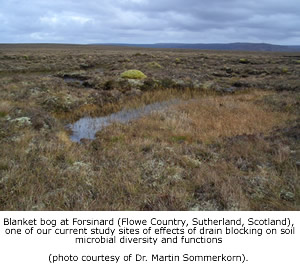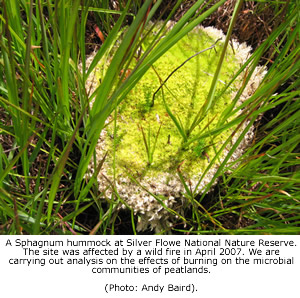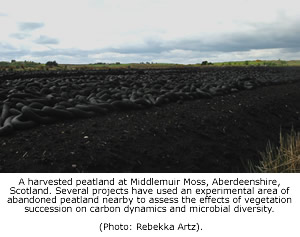 Welcome
Welcome
Our research group works on a variety of projects that investigate the ecology and ecosystem functions of microbiota in peatland ecosystems. This group formed as a continuation of the EU-funded RECIPE project but has now widened its scope to include research on restoration of heavily degraded ombrotrophic peatlands as well as studying the effects of anthropogenic activities such as climate change and increased N deposition on carbon cycling in peatland ecosystems. We have access to a wide variety of interesting field sites, a fully equipped molecular biology laboratory, excellent growth room and stable isotope facilities.
News
We have two vacancies for fully funded PhD students, starting October 2008 and further details can be found here. Please enquire (r.artz@macaulay.ac.uk) for any future opportunities.

Members
Current group members are:
- Dr. Rebekka Artz
- Pauline Currey (PhD student)
- Eileen Reid (Research Assistant)
- Dr. Frank van der Heijen (visiting Post-doc, Queen Mary London)
Past members:
- Dr. Clare Trinder, Joint PhD student with the University of Aberdeen
(NEWS: Clare recently completed her PhD and has now moved on to a postdoctoral position at the University of Aberdeen). - Dr. Hannah Toberman, Joint PhD student with CEH Bangor and the University of Wales, Bangor (NEWS: Hannah recently completed her PhD).
- Dr. Hung Nguyen-Viet, ESF Exchange visiting research fellow
- Weigang Yan, MSc student
- Mukunda Phuyal, MSc student

Ongoing research
Internal collaborations
Dr. Steve Chapman & Prof. Colin Campbell, through completed projects (RECIPE) and ongoing collaborative work within core work funded by the Scottish Government
Dr. Martin Sommerkorn Determination of Carbon fluxes in previously afforested blanked bog. In collaboration with RSPB Forsinard, CEH Edinburgh & ERI Thurso. Using stable isotope markers to identify microbial groups involved in degradation of recalcitrant plant litter
Dr.Lorna Dawson Development of wax biomarkers as proxies for past and present vegetation in peatland ecosystems (Joint PhD studentship, Pauline Currey)
External collaborations
Dr. David Johnson (University of Aberdeen) Joint PhD studentship of (now Dr) Clare Trinder (2004-2007) & ongoing collaboration on C cycling in peatland ecosystems
Dr. David Johnson, Dr. Gwen Grelet & Prof. Ian Alexander (New PhD studentship, starting October 2008, with the Aberdeen Mycorrhiza Research Group and University of Aberdeen)
Prof. John Cairney, Dr. Ian Anderson & Dr. Susan Chambers (University of Western Sydney, Australia). Ongoing collaborative work on functional genes of ericoid and ectomycorrhizal fungi involved in decompositional processes in peatlands (and other ecosystems)
Prof Chris Freeman & Dr. Nathalie Fenner, University of Wales, Bangor and Dr. Chris Evans, CEH Bangor. Joint PhD studentship of (now Dr.) Hannah Toberman (2004-2007) & ongoing collaborative work on phenol oxidase enzymes in peatlands
Prof Line Rochefort & Roxane Andersen at the PERG group, University of Laval, Canada, Royal Society of Edinburgh International Exchange grant (2008)
Dr. Lucy Sheppard and Ian Leith at CEH, Edinburgh & Dr. Rene van der Wal (University of Aberdeen) Whim Moss N deposition experiment, joint work on PhD project of Pauline Currey
Dr. Lisa Belyea & Prof. Andy Baird, Queen Mary University of London (NERC Urgency grant, Effects of fire on microbial community structure in peatland ecosystems, 2007-2008)
Dr. Nick Ostle (CEH Lancaster) & Prof. Richard Bardgett (Lancaster University). New PhD studentship, starting October 2008
Dr. Hedda Weitz (University of Aberdeen) Functional genes in bioluminescent fungi
Most recent publications
- Trinder, C.J., Artz, R.R.E.,and D. Johnson (In press) Contribution of plant photosynthate to soil respiration and dissolved organic carbon in a naturally recolonising cutover peatland. Soil Biology and Biochemistry.
- Toberman, H., Evans, C., Freeman, C., Fenner, N. and Artz, R.R.E. (In Press) Summer drought effects upon soil and litter extracellular phenol oxidase activity and soluble carbon release in an upland Calluna heathland. Soil Biology and Biochemistry (doi: 10.1016/j.soilbio.2008.01.004)
- Trinder, C.J., Artz, R.R.E. and Johnson, D. (2008) Temporal patterns of litter production by vascular plants colonising cut-over peatlands. Wetlands 28: 524-250.
- Chapman, S.J., Campbell, C.D. and Artz, R.R.E. (2008). Assessing CLPPs using MicroRespTM. Journal of Soils and Sediments 7: 406-410.
- Yan, W., Artz, R.R.E. and D. Johnson. (2008) Species-specific effects of plant colonising cut-over peatlands on patterns of carbon source utilisation by soil microorganisms. Soil Biology and Biochemistry 40: 544-549.
- Phuyal, M., Artz, R.R.E., Sheppard, L. and D. Johnson. (2008)Long-term nitrogen deposition increases phosphorus limitation of bryophytes in an ombrotrophic bog. Plant Ecology (doi: 10.1007/s11258-007-9338-1)
- Artz, R.R.E., Chapman, S.J., Robertson, A.H.J., Potts, J.M., Laggoun-Defarge, F., Gogo, S., Comont, L., Disnar, J.-R., and A.J. Francez (2008). FTIR spectrocopy can be used as a screening tool for organic matter quality in regenerating peatlands. Soil Biology and Biochemistry 40: 515-527.
- Artz R.R.E., Anderson, I.C., Chapman, S.J., Hagn, A. Schloter, M., Potts, J.M. and C.D. Campbell.(2007) Fungal diversity and community composition change in response to vegetational succession during natural regeneration of cut-over peatlands. Microbial Ecology 54: 508-522.
- Artz, R.R.E., Chapman, S.J. and C.D. Campbell. (2006) Substrate utilisation profiles of microbial communities in peat are depth-dependent and correlate with whole soil FTIR profiles. Soil Biology and Biochemistry 38: 2958-2962.
|
Updated: 23 Jan 2024, Content by: RA
|
